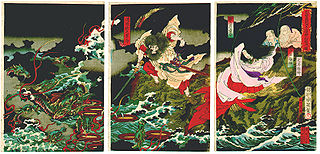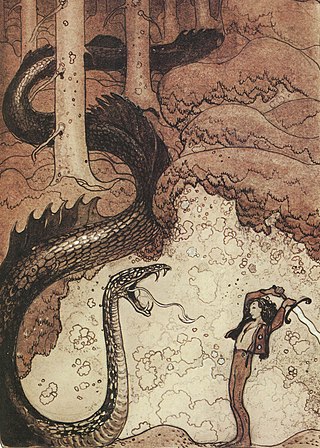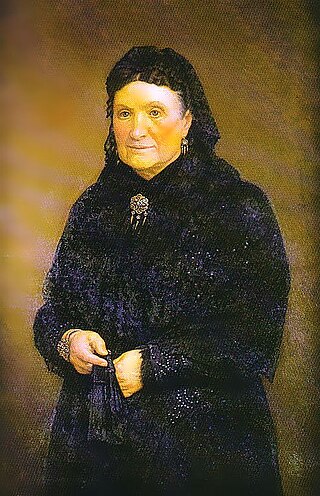
A dragon is a magical legendary creature that appears in the folklore of multiple cultures worldwide. Beliefs about dragons vary considerably through regions, but dragons in Western cultures since the High Middle Ages have often been depicted as winged, horned, and capable of breathing fire. Dragons in eastern cultures are usually depicted as wingless, four-legged, serpentine creatures with above-average intelligence. Commonalities between dragons' traits are often a hybridization of feline, reptilian, mammalian, and avian features.

The European dragon is a legendary creature in folklore and mythology among the overlapping cultures of Europe.

Yamata no Orochi, or simply Orochi (大蛇), is a legendary eight-headed and eight-tailed Japanese dragon/serpent.

In mythology, folklore and speculative fiction, shapeshifting is the ability to physically transform oneself through unnatural means. The idea of shapeshifting is found in the oldest forms of totemism and shamanism, as well as the oldest existent literature and epic poems such as the Epic of Gilgamesh and the Iliad. The concept remains a common literary device in modern fantasy, children's literature and popular culture. Examples of shapeshifters are vampires and werewolves.

The lindworm, also spelled lindwyrm or lindwurm, is a mythical creature in Northern, Western and Central European folklore that traditionally has the shape of a giant serpent monster living deep in the forest. It can be seen as a sort of dragon.

Princess and dragon is an archetypical premise common to many legends, fairy tales, and chivalric romances. Northrop Frye identified it as a central form of the quest romance.

Amaya o los vascos en el siglo VIII is a Romantic historical novel published in 1877 and in 1879 by Francisco Navarro-Villoslada, a noted novel by a Navarrese author. The story is placed during the invasion of Visigothic Kingdom by the Moors. In line with the author's conspiracist imaginary, the story-building is permeated by anti-Semitic prejudice.

Mari, also called Mari Urraca, Anbotoko Mari, and Murumendiko Dama, is the main goddess of the ancient Basque mythology, who is said to mainly live on the eastern slope of Mount Anboto. From there she takes care of the environment and dispenses justice. When clouds appear around Anboto it is said the this is because Mari has returned to her home on this mountain, the so-called "Cave of The Lady". She is married to the god Sugaar.

Tartaro, Tartalo, or Torto in Basque mythology, is an enormously strong one-eyed giant very similar to the Greek Cyclops that Odysseus faced in Homer's Odyssey. He is said to live in caves in the mountains and catches young people in order to eat them; in some accounts he eats sheep also.
In Pahang Malay folklore, the Seri Gumum Dragon is a legendary giant serpent locally called Nāga and commonly described as taking the form of an Asian dragon, that inhabit the Chini Lake in Pahang, Malaysia. There have been a variety of legends associated with the creature in the oral literature. The notable one is related to the origin myth of the lake itself, while another legend narrates about a love story between female Seri Gumum and a male Nāga called Seri Kemboja that leads to the origin myth of Tioman and Lingga Islands.

The Death of Koschei the Deathless or Marya Morevna is a Russian fairy tale collected by Alexander Afanasyev in Narodnye russkie skazki and included by Andrew Lang in The Red Fairy Book. The character Koschei is an evil immortal man who menaces young women with his magic.
The Aralar Range is a mountain range in the Basque Mountains of the Southern Basque Country. The part of the range lying in Gipuzkoa was established as a conservation area called Aralar Natural Park in 1994. In addition to its natural features, scenery, recreational use and habitation, the range is home to a number of Basque mythology milestones and legends.

A dragonslayer is a person or being that slays dragons. Dragonslayers and the creatures they hunt have been popular in traditional stories from around the world: they are a type of story classified as type 300 in the Aarne–Thompson classification system. They continue to be popular in modern books, films, video games and other forms of entertainment. Dragonslayer-themed stories are also sometimes seen as having a chaoskampf theme—in which a heroic figure struggles against a monster that epitomises chaos.

Casilda Iturrizar, also known as the Epalza widow, was a Spanish philanthropist and businessperson from Bilbao in the Basque Country. Iturrizar sought to help the most disadvantaged members of Bilbao society using her fortune for charity. The street where she lived, a hospital wing, and a city park were named after her.

King Lindworm or Prince Lindworm is a Danish fairy tale published in the 19th century by Danish folklorist Svend Grundtvig. The tale is part of the more general cycle of the Animal as Bridegroom, and is classified in the Aarne–Thompson–Uther Index as tale type ATU 433B, a type that deals with maidens disenchanting serpentine husbands.

Arwe, also known as Wainaba, in Ethiopian mythology, is a serpent-king who rules for four hundred years before being destroyed by the founder of the Solomonic dynasty. His story comes in a number of versions, all of which have him as a tyrannical ruler who demands sacrifice. The myth is part of a wider tradition of serpent- or dragon-kings, such as the Babylonian dragon.
Habrmani, Habermani or Habermany, the Serpent-Prince is an Armenian folktale about a serpent prince that marries a human maiden. The tale has been compared to the international cycle of the Animal as Bridegroom or The Search for the Lost Husband, wherein a human heroine marries a husband of supernatural origin, loses him and has to seek him out.
The Ruby Prince is a South Asian folktale, first published in the late 19th century by author Flora Annie Steel. The tale is a local form of the cycle of the Animal as Bridegroom or The Search for the Lost Husband, in that a woman marries a man of supernatural origin, loses him and must regain him.
Dragon-Child and Sun-Child is an Armenian fairy tale. The tale is part of the more general cycle of the Animal as Bridegroom, and is classified in the Aarne–Thompson–Uther Index as tale type ATU 433B, "King Lindworm", a type that deals with maidens disenchanting serpentine husbands. In the Armenian variants of the tale type, however, the story continues with the adventures of the banished heroine, who meets a cursed man, rescues and marries him, and eventually is found by her first husband, the snake prince whom she disenchanted before.












